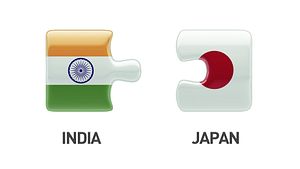The timing of Prime Minister Narendra Modi’s visit to Japan, scheduled from August 31 to September 3, is slightly off. However, what has been lost in timing can be made up in the rhetoric of the joint statement. The visit to Japan was initially scheduled for July 3 to July 5. Modi had to postpone the visit due to the Budget Session of Parliament beginning from July 7.
Had the initial visit materialized, consider the chronology of events that would have been witnessed: 1) Tibetan Prime Minister in-exile Lobsang Sangay visits India for Modi’s swearing-in ceremony on May 26; 2) Japanese Prime Minister Shinzo Abe’s Cabinet announces a reinterpretation of the country’s pacifist Constitution (specifically Article 9) on July 1 that would allow Japanese Self-Defense Forces to come to the aid of allied countries under attack; and 3) Modi, who is believed to share very good personal relations with Abe, visiting Japan on July 3. The combined impact of these three events in succession could have sent a clear message to Beijing, that the new government under Modi would not allow China to assert its primacy in the region.
The missed opportunity of not visiting Japan early enough should now be offset by the rhetoric of the joint statement. The converging geo-political interests of India and Japan in curbing the growing assertiveness of China in the Asia-Pacific is certainly one of the major factors binding the two nations together. While the unresolved border dispute between India and China has continued for more than six decades, a relatively newer aggressive posture by China vis-à-vis Japan over the ownership of the Senkaku/Diaoyu Islands in the East China Sea has opened up new opportunities for cooperation between India and Japan.
India and Japan also share a basic commitment to liberal democratic governance, which sets them apart from authoritarian China. China also opposes India and Japan being given permanent seats on the United Nations Security Council. In light of these reasons, a joint statement in the upcoming visit has to be high on rhetoric. The statement will do well to recognise India as a “friend” of Japan, which will be eligible to reap the benefits of the reinterpretation of Article 9 of the Japanese Constitution.
The statement should also adopt a mix of subtle and open references to Chinese claims in both the East China Sea and the Indian territories of Ladakh and Arunachal Pradesh. The statement should warn against any sort of unilateral adventurism adopted by any country (read China) to settle territorial disputes. The joint statement should go a step further to condemn any sort of invasion, including “cartographic invasion,” a method deftly and routinely adopted by the Chinese. The statement should also reaffirm the joint demands of India and Japan to become permanent members of the U.N. Security Council. With John Kerry reaffirming the U.S. support for Indian Security Council membership, three of the four largest economies of the world are on board to broaden the Council’s membership. China should not be allowed to nix the proposal.
The absence of a bitter historical dispute between India and Japan allows Modi and Abe, two nationalist prime ministers, to increase mutual cooperation. It is true that the relationship saw a difficult period following the Pokhran nuclear tests in 1998, with Japan imposing various sanctions on India. The impasse was later resolved with global reconsideration of India’s security imperatives, and Japanese Prime Minister Yoshiro Mori paying a visit to India in 2000.
While the civil nuclear cooperation deal is on the table, efforts should be made to dramatically increase trade between the two countries. The current trade volume of $19 billion paints a picture of missed opportunities between the third and fourth largest economies of the world. India also needs Japan to finance its ambitious infrastructure projects like railway modernization, highway construction, the Delhi-Mumbai Industrial Corridor and the building of “smart” cities.
The potential of economic cooperation backed by the convergence of geo-political interests, lays the foundations of long-term strategic cooperation between the two countries. Abe in his book Towards a Beautiful Country says, “It will not be a surprise if in another decade Japan-India relations overtake Japan-U.S. and Japan-China ties.” While eight years have passed since the book was published, India-Japan relations have not moved closer to Abe’s vision. If trade is one indicator, Japan-U.S. ties ($204 billion) and Japan-China ties ($312 billion) are far ahead of Japan-India ties ($19 billion). A correction is in order.
While addressing the joint session of the Indian Parliament in 2007, Abe said the “Japan-India relationship is blessed with the largest potential for development of any bilateral relationship anywhere in the world.” Now is the time to translate those words into action.
Kunal Singh is a Research Associate at the Centre for Policy Research (CPR). Follow him on Twitter @kunaldrajput.

































